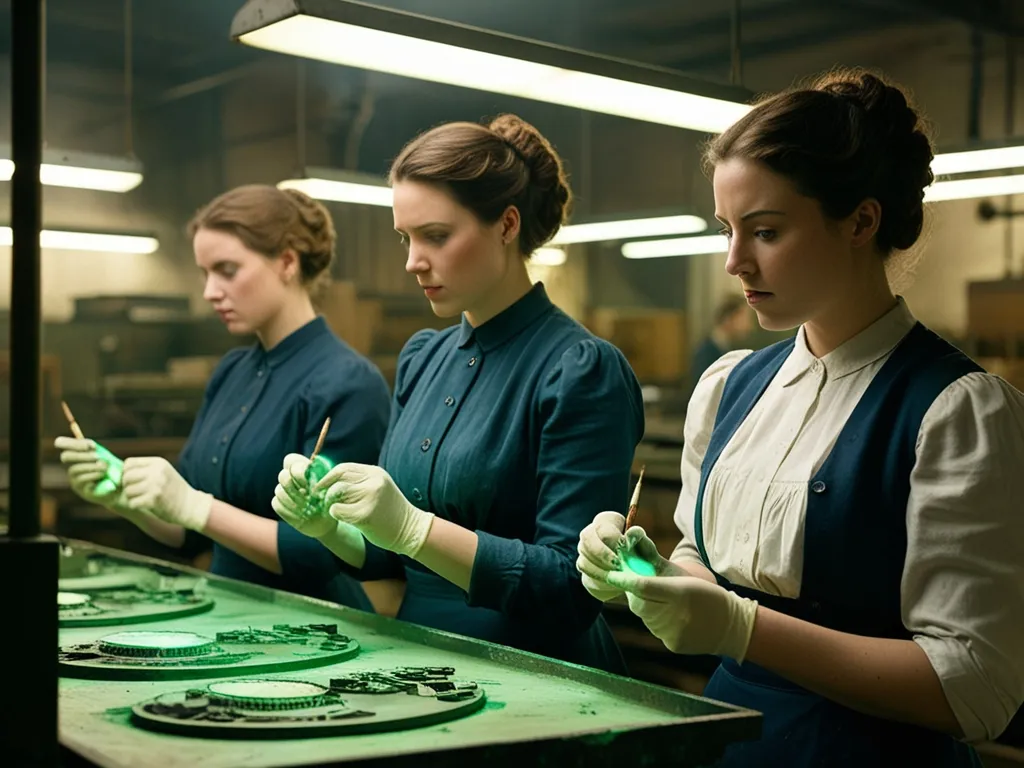In the early 20th century, a group of young women, mostly teenagers and immigrants, found employment in factories across the United States, particularly in New Jersey, Illinois, and Connecticut. Their job was to paint watch dials with a glow-in-the-dark substance containing radium, a element that had been discovered just a few decades earlier by French physicists Marie and Pierre Curie. What seemed like a lucrative and prestigious job at the time would eventually turn into a nightmare, leading to one of the most tragic and influential labor rights cases in American history.
These women, later known as the “Radium Girls,” were hired for their dexterity and fine motor skills, which were essential for the precise work of painting tiny numbers on watch faces. The job was well-paying and considered respectable, especially for women who were just starting to enter the workforce. However, the allure of this job was short-lived.
The radium paint used by these women was highly radioactive, and they were instructed to use their lips to shape the fine tips of their brushes, a practice known as “lip pointing.” This method ensured the brushes were sharp enough to paint the small numbers, but it also meant that the women were ingesting small amounts of radium daily. Unaware of the dangers, they even applied the paint to their teeth to achieve a radiant smile before going out dancing.
As time passed, the Radium Girls began to fall ill with mysterious and agonizing symptoms. Their teeth would ache and fall out, leaving gaping holes that would not heal and instead form painful abscesses. They developed severe anemia, and their bones became brittle. The most horrific symptom was jaw necrosis, where their bone and tissue cells would be starved of blood and die, causing their faces to literally rot away.
Doctors were initially baffled by these illnesses, and the women’s employer, the United States Radium Corporation, denied any connection between the girls’ health issues and their work. The company went so far as to claim that the women were suffering from syphilis, a highly stigmatized sexually transmitted infection at the time, in an attempt to discredit them and avoid responsibility.
The turning point came when a pathologist named Harrison Martland developed a test that conclusively proved that radium was the cause of the women’s illnesses. Despite this evidence, the company continued to deny any wrongdoing and even commissioned fraudulent studies to support their claims. It wasn’t until the Radium Girls themselves took action that the truth began to surface.
In 1927, a group of five surviving Radium Girls, including Katherine Schaub, Grace Fryer, Quinta Maggia McDonald, Albina Maggia Larice, and Edna Hussman, filed a lawsuit against their former employer. The trial was a harrowing experience for the women, who were all severely ill by this point. Fearing they would not survive a lengthy trial, they settled out of court for $10,000 in damages and $600 per year for the rest of their lives, along with all their legal and medical bills to be paid by the company. However, the company was not required to take any legal responsibility for the women’s illnesses.
The legacy of the Radium Girls extends far beyond their personal tragedies. Their case was one of the first in which a company was held accountable for the health and safety of its employees, leading to significant reforms in labor laws. The U.S. Occupational Safety and Health Administration (OSHA) was eventually established, in part due to the public outcry and legal battles fought by these women.
The research conducted on the Radium Girls also contributed immensely to the understanding of radioactivity’s health effects. The women who survived the initial poisoning continued to be studied for decades, undergoing regular tests, including bone marrow biopsies, blood tests, x-rays, and physical exams. These studies were crucial in understanding the long-term effects of radium exposure and helped in the development of safer working practices in the radium industry.
One of the most poignant aspects of the Radium Girls’ story is the personal sacrifice they made for future generations. Despite knowing their days were numbered, they cooperated with scientists, providing invaluable data that saved countless lives. Their bodies, even after death, continued to serve as a reservoir of scientific information. Special lead-lined rooms were constructed to measure the quantity of radium in their bodies, helping to establish the Center for Human Radiobiology.
The impact of the Radium Girls’ case can also be seen in broader policy changes. In 1963, partly in response to the research on these women, President John F. Kennedy signed the International Limited Test Ban Treaty, which prohibited atomic tests above ground, under water, and in outer space. This treaty was a significant step in recognizing the dangers of radioactive materials and the need for stringent safety regulations.
Today, as we reflect on the story of the Radium Girls, it serves as a stark reminder of the importance of workplace safety and the need for transparency and accountability from employers. Their story is not just a historical footnote but a living testament to the power of collective action and the enduring impact of personal sacrifice on public policy and scientific knowledge.
In an era where science and technology are advancing at an unprecedented pace, the Radium Girls’ story reminds us that progress must always be balanced with safety and ethical considerations. Their fight against a powerful corporation and their contribution to medical science are lessons that continue to resonate, urging us to prioritize human well-being over economic interests.
The Radium Girls may have suffered in silence for a time, but their voices have now become a beacon for labor rights and safety standards worldwide. Their glow, though initially from the radioactive paint, now shines brightly as a symbol of resilience and the fight for justice.





